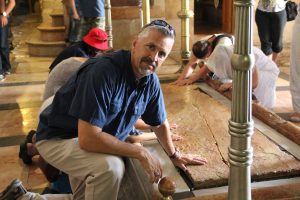 “Train up a child in the way he should go: and when he is old, he will not depart from it” (Proverbs 22:6 KJV).
“Train up a child in the way he should go: and when he is old, he will not depart from it” (Proverbs 22:6 KJV).
When we first moved to North Carolina our children were ages five, two, and one. None of them could ride a bike without training wheels. The youngest was still mastering the art of walking.
Stephen, our oldest, hadn’t been able to practice riding at our previous home in Virginia. Our old driveway was too steep and it ended on a two-lane highway. Not a good place to learn how to ride a bike. But our new home in Wilson, NC had a long, level concrete driveway, perfect for bicycle practice. Plus, it had a fenced-in backyard with a gate closing off the driveway from the main road.
Stephen and his two-year old little brother, Jonathan, spent every day riding between the closed gate and the garage in the backyard. Stephen rode his little blue bike with training wheels and Jonathan followed on his “big wheel.” Little by little I raised the training wheels on Stephen’s bike, so that they only touched the ground when he leaned too far. Within a couple of months, Stephen was riding his bike without training wheels.
We also bought Jonathan a little red bike with training wheels that year. He was so focused on keeping up with his big brother that I started raising his training wheels too. Robin worried about this. She said, “I think he’s too little, Gary.”
But I’d been watching him and he really seemed to have the balance, so I took his training wheels off too. “He can do it.” I replied. “Just watch.”
And he did. Our little two-year old was soon chasing his big brother around the driveway without training wheels too. He was like a bicycle prodigy or something!
Before long I started leading my little bicycle tribe out onto the road in our subdivision. I had installed a child seat on the back of my old 10-speed, so baby Erin could join the fun. Before we headed out I always had a huddle with the team to plan our journey.
“Stephen, you lead the way, but don’t go too fast. Make sure your brother is keeping up. And remember to stop at the stop sign.” I instructed.
“OK, Daddy.” He replied.
“What?” I asked, with a perturbed look.
“Yes, my father.” He replied, a look of intensity in his eyes as he accepted the responsibility of leading (When I gave out formal mission plans, the boys had to respond with “My father.” It was part of the training).
“Jonathan, you follow your brother. Remember, to stay right behind him and don’t weave around and stuff. And most of all, don’t forget to use your brakes to stop.” I told my younger son, while looking in his eyes (Jonathan had a bad habit of stopping by dragging his feet on the ground rather than using the coaster brake.).
“Yes, my father.” He said with his little scratchy voice and a nod of his head. He was already bumping Stephen with his bike tire, rearing to get on the road.
“Are you ready, Erin?” I asked, leaning around to look at her there on the back of my bike.
She just nodded and smiled. She hadn’t worked out the talking thing yet.
We headed out onto the road with Stephen in the lead, Jonathan in the middle, and myself and Erin bringing up the rear. This put me in a position to keep an eye on the pack and shout instructions along the way.
“Turn left after stopping, Stephen.” I shouted.
“Yes Sir.” He said while gesturing a left turn with his arm (Yes, they had to use turn signals).
Little by little, we traveled farther and farther from home as the children grew. Time flew. It didn’t seem that long before I was handing each of them car keys and then seeing them graduate and marry. Every step we just kept raising the training wheels a little higher.
 As I prepare to close out our parenting series this Sunday, I’m reminded of how much parenting and bike riding have in common. At first, they both involved use of my authority more than my influence. I had to teach them to obey my instructions. But along the way I also kept raising their training wheels, so that they had more and more authority of their own. I moved from a position of absolute authority, to the voice of influence.
As I prepare to close out our parenting series this Sunday, I’m reminded of how much parenting and bike riding have in common. At first, they both involved use of my authority more than my influence. I had to teach them to obey my instructions. But along the way I also kept raising their training wheels, so that they had more and more authority of their own. I moved from a position of absolute authority, to the voice of influence.
The art of parenting is recognizing this transition from authority to influence. We exercise our authority while they are young, but as they grow we must exchange authority for influence. We must begin trusting them with more authority along the way, as we teach them “the way they should go.”
That’s the key. First, teach them to obey, then teach them to know “the way.” When we do this, our authority will gradually decrease, but it will be replaced by a growing influence that will last the rest of our days together.
We want our children to ultimately be followers of God’s way. As parents, we have a holy stewardship. God gives our children to us and we raise them up and give them back to Him.
Adapted from my previous blog entry on June 4, 2010.





















 “And he said to them, ‘I have earnestly desired to eat this Passover with you before I suffer’” (Luke 22:15 ESV).
“And he said to them, ‘I have earnestly desired to eat this Passover with you before I suffer’” (Luke 22:15 ESV).